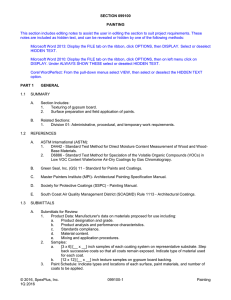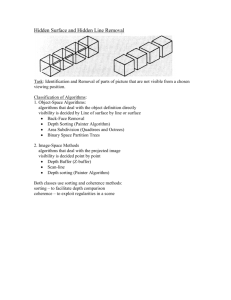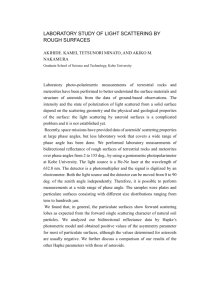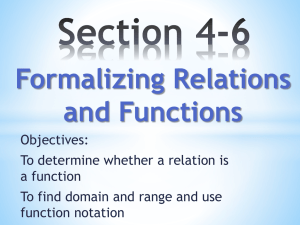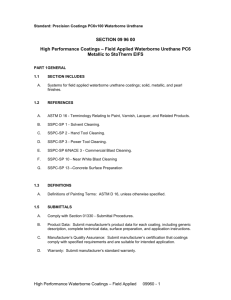Module I cotaings Engineers revised
advertisement
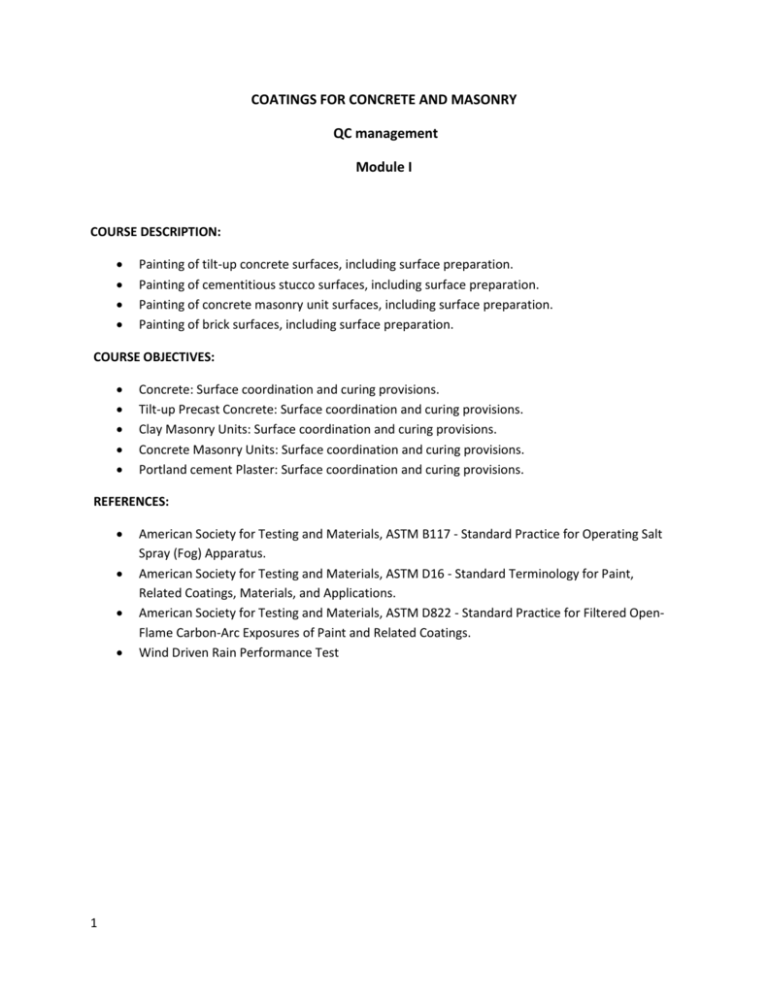
COATINGS FOR CONCRETE AND MASONRY QC management Module I COURSE DESCRIPTION: Painting of tilt-up concrete surfaces, including surface preparation. Painting of cementitious stucco surfaces, including surface preparation. Painting of concrete masonry unit surfaces, including surface preparation. Painting of brick surfaces, including surface preparation. COURSE OBJECTIVES: Concrete: Surface coordination and curing provisions. Tilt-up Precast Concrete: Surface coordination and curing provisions. Clay Masonry Units: Surface coordination and curing provisions. Concrete Masonry Units: Surface coordination and curing provisions. Portland cement Plaster: Surface coordination and curing provisions. REFERENCES: 1 American Society for Testing and Materials, ASTM B117 - Standard Practice for Operating Salt Spray (Fog) Apparatus. American Society for Testing and Materials, ASTM D16 - Standard Terminology for Paint, Related Coatings, Materials, and Applications. American Society for Testing and Materials, ASTM D822 - Standard Practice for Filtered OpenFlame Carbon-Arc Exposures of Paint and Related Coatings. Wind Driven Rain Performance Test SPECIFIC EDUCATIONAL OUTCOMES: 2 General: Standard coating terms defined in ASTM D16. Flat refers to a lustreless or matte finish with a gloss range below 15 when measured at an 85degree meter. Eggshell refers to low-sheen finish with a gloss range between 20 and 35 when measured at a 60-degree meter. Semi-gloss refers to medium-sheen finish with a gloss range between 35 and 70 when measured at a 60-degree meter. Full gloss refers to high-sheen finish with a gloss range more than 70 when measured at a 60degree meter. Environments: The following terms distinguish between different corrosive exposures: Severe environments" are highly corrosive industrial atmospheres with sustained exposure to high humidity and condensation and with frequent cleaning using strong chemicals. Environments with heavy concentrations of strong chemical fumes and frequent splashing and spilling of harsh chemical products are severe environments. Moderate environments" are corrosive industrial atmospheres with intermittent exposure to high humidity and condensation, occasional mould and mildew development, and regular cleaning with strong chemicals. Environments with exposure to heavy concentrations of chemical fumes and occasional splashing and spilling of chemical products are moderate environments. Mild environments" are industrial atmospheres with normal exposure to moderate humidity and condensation, occasional mould and mildew development, and infrequent cleaning with strong chemicals. Environments with low levels of mild chemical fumes and occasional splashing and spilling of chemical products are mild environments. Normal outdoor weathering is also considered a mild environment. QUALITY ASSURANCE: Installer Qualifications: A firm or individual experienced in applying paints and coatings similar in material, design, and extent to those indicated for this Project, whose work has resulted in applications with a record of successful in-service performance. Manufacturer Qualifications: A firm with minimum 10 years successful experience with coatings specified in this Section. Obtain block fillers and primers for each coating system from the same manufacturer as the finish coats. Surfaces to be painted: Paint exposed surfaces. If an item or a surface is not specifically mentioned, paint the item or surface the same as similar adjacent materials or surfaces. If a colour or finish is not indicated, Architect will select from colours and finishes available. Do not paint prefinished items, concealed surfaces, finished metal surfaces, operating parts, and labels. Mock-Up: Provide a mock-up for evaluation of surface preparation techniques and application workmanship: Finish areas designated by Architect. Do not proceed with remaining work until workmanship, colour, and sheen are approved by Architect. Refinish mock-up area as required to produce acceptable work. DELIVERY, STORAGE, AND HANDLING: Deliver materials to Project site in manufacturer's original, unopened packages and containers bearing manufacturer's name and label: Store materials not in use in tightly covered containers in a well-ventilated area at a minimum ambient temperature of 45 deg F (7 deg C). Maintain storage containers in a clean condition, free of foreign materials and residue. PROJECT CONDITIONS: 3 Maintain environmental conditions (temperature, humidity, and ventilation) within limits recommended by manufacturer for optimum results. Do not install products under environmental conditions outside manufacturer's absolute limits. Unless indicated otherwise apply waterborne paints only when temperatures of surfaces to be painted and surrounding air are between 50 and 90 deg F (10 and 32 deg C). Unless indicated otherwise apply solvent-thinned paints only when temperatures of surfaces to be painted and surrounding air are between 45 and 95 deg F (7 and 35 deg C). Do not apply paint in snow, rain, fog, or mist; or when relative humidity exceeds 85 present; or at temperatures less than 5 deg F (3 deg C) above the dew point; or to damp or wet surfaces. Painting may continue during inclement weather if surfaces and areas to be painted are enclosed and heated within temperature limits specified by manufacturer during application and drying periods PAINT MATERIALS – GENERAL: Material Compatibility: Provide block fillers, primers, and finish-coat materials that are compatible with one another and with the substrates indicated under conditions of service and application, as demonstrated by manufacturer based on testing and field experience. VOC Classification: Provide masonry coating materials, including primers, undercoats, and finish-coat materials, that have a VOC classification meeting AIM standards. Performance: Paint system shall provide wind driven rain resistance meeting Wind Driven Rain test Fed. Spec. TT-C-555-B. Colour: Refer to Finish Schedule and Paint Legend for paint colours. PRIMERS/SEALERS: Examples Alkali Resistant Primer: Perma-Crete High Build Acrylic Primer 100 per cent acrylic latex. Low temperature application. Mildew resistant on the dry paint film. Sheen: Flat. Volume Solids: 40 percent. VOC: 0.82 lb/gal. Recommended Dry Film Thickness: 2.6 mils to 3.2 mils (0.07 mm to 0.08 mm). Alkali Resistant Primer: Pittsburgh Paints Perma-Crete Alkali Resistant Primer 4-603. 100 percent acrylic latex. Low temperature application. Instructor – James F Hayden: MSc construction Management, Certified License registered masonry engineer Information Technologists MIA This onsite training is aimed at not only resident project representatives on construction projects, but also project managers, contract administrators, architects, engineers, owners, and supervisory and field management personnel. The focus is on the resident project representative and his interaction with all these parties and the problems they encounter and must resolve. The training analyses the construction process to include project delivery systems, documentation, responsibilities, authorities, specifications, preconstruction operations, scheduling, construction operations, risk allocation, and information technology. Attendees will learn procedures and contract specification language that help minimize disputes and avoid claims. 4 5

